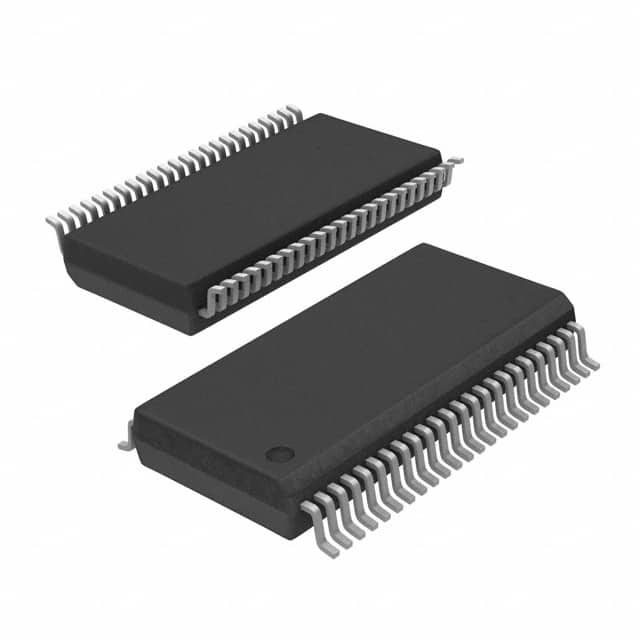Encyclopedia Entry: 74ACT16541TTR
Product Overview
Category
The 74ACT16541TTR belongs to the category of integrated circuits (ICs) and specifically falls under the family of digital logic ICs.
Use
This IC is commonly used in electronic devices for data storage and transfer applications. It serves as a 16-bit buffer/line driver with 3-state outputs.
Characteristics
- The 74ACT16541TTR operates on a supply voltage range of 4.5V to 5.5V.
- It offers high-speed operation, making it suitable for applications requiring fast data transfer.
- This IC has 3-state outputs, allowing multiple devices to share a common bus without interference.
- It features a wide operating temperature range, typically from -40°C to +85°C.
- The 74ACT16541TTR is designed to be compatible with TTL input and output levels.
Package
The 74ACT16541TTR is available in a TSSOP (Thin Shrink Small Outline Package) package. This package type provides a compact form factor and allows for easy integration into various electronic systems.
Essence
The essence of the 74ACT16541TTR lies in its ability to efficiently store and transfer digital data within electronic devices. It acts as a reliable buffer and line driver, ensuring smooth communication between different components.
Packaging/Quantity
The 74ACT16541TTR is typically sold in reels or tubes, containing a specific quantity of ICs per package. The exact packaging and quantity may vary depending on the supplier.
Specifications
- Number of Bits: 16
- Logic Family: ACT
- Supply Voltage Range: 4.5V to 5.5V
- Input Compatibility: TTL
- Output Type: 3-State
- Operating Temperature Range: -40°C to +85°C
- Package Type: TSSOP
Detailed Pin Configuration
The 74ACT16541TTR has a total of 48 pins, which are assigned specific functions. The pin configuration is as follows:
- Pin 1: Output Enable (OE)
- Pin 2: Input Data (D0)
- Pin 3: Input Data (D1)
- Pin 4: Input Data (D2)
- Pin 5: Input Data (D3)
- Pin 6: Input Data (D4)
- Pin 7: Input Data (D5)
- Pin 8: Input Data (D6)
- Pin 9: Input Data (D7)
- Pin 10: Input Data (D8)
- Pin 11: Input Data (D9)
- Pin 12: Input Data (D10)
- Pin 13: Input Data (D11)
- Pin 14: Input Data (D12)
- Pin 15: Input Data (D13)
- Pin 16: Input Data (D14)
- Pin 17: Input Data (D15)
- Pin 18: Ground (GND)
- Pin 19: Output Data (Q0)
- Pin 20: Output Data (Q1)
- Pin 21: Output Data (Q2)
- Pin 22: Output Data (Q3)
- Pin 23: Output Data (Q4)
- Pin 24: Output Data (Q5)
- Pin 25: Output Data (Q6)
- Pin 26: Output Data (Q7)
- Pin 27: Output Data (Q8)
- Pin 28: Output Data (Q9)
- Pin 29: Output Data (Q10)
- Pin 30: Output Data (Q11)
- Pin 31: Output Data (Q12)
- Pin 32: Output Data (Q13)
- Pin 33: Output Data (Q14)
- Pin 34: Output Data (Q15)
- Pin 35: Output Enable (OE)
- Pin 36: Ground (GND)
- Pin 37: Clock (CLK)
- Pin 38: Clock Enable (CE)
- Pin 39: Ground (GND)
- Pin 40: VCC (+5V)
Functional Features
The 74ACT16541TTR offers the following functional features:
- Data Storage: It can store digital data on its 16 input pins.
- Data Transfer: The IC enables the transfer of stored data to the corresponding output pins.
- Output Enable Control: The OE pins allow for enabling or disabling the outputs, providing flexibility in data transmission.
- Clock Input: The CLK pin synchronizes the data transfer process. 5
قم بإدراج 10 أسئلة وإجابات شائعة تتعلق بتطبيق 74ACT16541TTR في الحلول التقنية
Sure! Here are 10 common questions and answers related to the application of 74ACT16541TTR in technical solutions:
Question: What is the 74ACT16541TTR?
- Answer: The 74ACT16541TTR is a 16-bit buffer/line driver with 3-state outputs, commonly used in digital systems.Question: What is the purpose of using the 74ACT16541TTR in a technical solution?
- Answer: The 74ACT16541TTR is used to provide buffering and line driving capabilities for digital signals, ensuring proper signal integrity and compatibility between different components.Question: How many inputs can the 74ACT16541TTR handle?
- Answer: The 74ACT16541TTR has 16 inputs, allowing it to handle up to 16 digital signals.Question: Can the 74ACT16541TTR be used for bidirectional communication?
- Answer: No, the 74ACT16541TTR is a unidirectional buffer/line driver and does not support bidirectional communication.Question: What is the voltage range supported by the 74ACT16541TTR?
- Answer: The 74ACT16541TTR supports a voltage range of 2V to 6V, making it compatible with various digital logic families.Question: Does the 74ACT16541TTR have internal pull-up or pull-down resistors?
- Answer: No, the 74ACT16541TTR does not have internal pull-up or pull-down resistors. External resistors may be required for proper signal termination.Question: Can the 74ACT16541TTR drive capacitive loads?
- Answer: Yes, the 74ACT16541TTR can drive capacitive loads up to a certain limit. It is important to consider the capacitive load specifications mentioned in the datasheet.Question: What is the maximum operating frequency of the 74ACT16541TTR?
- Answer: The maximum operating frequency of the 74ACT16541TTR depends on various factors such as supply voltage, load capacitance, and temperature. Refer to the datasheet for detailed information.Question: Can multiple 74ACT16541TTR devices be cascaded together?
- Answer: Yes, multiple 74ACT16541TTR devices can be cascaded together to increase the number of inputs or outputs in a system.Question: Are there any special considerations when designing with the 74ACT16541TTR?
- Answer: When designing with the 74ACT16541TTR, it is important to consider factors such as power supply decoupling, signal integrity, noise immunity, and proper grounding techniques to ensure reliable operation.
Please note that these questions and answers are general in nature and may vary depending on specific application requirements. Always refer to the datasheet and consult with technical experts for accurate information.


